Products
Air Handling Units
The term grille is commonly applied to any air outlet or intake that consists of a square or rectangular face and neck, and
whose facial appearance is made up of stationary or adjustable louvers which may be used to deflect the air.
A register is a grille with moving parts, capable of being opened and closed and the air flow directed, which is part of a
building’s heating, ventilation, and air conditioning (HVAC) system. The placement and size of registers is critical to HVAC
efficiency. Register dampers are also important, and can serve a safety function.
However, in practice, the terms “grille”, “register”, and “return” are often used interchangeably, and care must be taken to
determine the meaning of the term used.
Placement of registers is key in creating an efficient HVAC system. Usually, a register is placed near a window or door,
which is where the greatest heat/cooling loss occurs. In contrast, returns (grilled ducts which suck air back into the HVAC
system for heating or cooling) are usually placed in the wall or ceiling nearest the center of the building. Generally, in rooms
where it is critical to maintain a constant temperature two registers (one placed near the ceiling to deliver cold air, and one
placed in the floor to deliver hot air) and two returns (one high, one low) will be used. HVAC systems generally have one
register and one return per room.
Registers vary in size with the heating and cooling requirements of the room. if a register is too small, the HVAC system will
need to push air through the ducts at a faster rate in order to achieve the desired heating or cooling. This can create rushing
sounds which can disturb occupants or interfere with conversation or work (such as sound recording). The velocity of air
through a register is usually kept low enough so that it is masked by background noise. (Higher ambient levels of background
noise, such as those in restaurants, allow higher air velocities.) On the other hand, air velocity must be high enough to
achieve the desired temperature. Registers are a critical part of the HVAC system. If not properly installed and tightly
connected to the ductwork, air will spill around the register and greatly reduce the HVAC system’s efficiency. Ideally, a room
will have both heating and cooling registers. In practice, cost considerations usually require that heating and cooling be
provided by the same register. In such cases, heating most often takes precedence over cooling, and registers are usually
found close to the floor.
Diffusers are an outlet which discharges supply air in various directions and planes purposes.
Diffusers are the vent covers through which climate-controlled air is delivered to a room.
Evenly distributes the flow of air in the desired directions.
Enhances the mixing of room air by entraining the room air into the diffuser’s primary air jet
Floor, wall, and ceiling diffusers are common in both commercial and residential buildings.
Reduces the velocity of the air as it passes through the system
Often uses Coanda Effect to attach a jet of air to the ceiling or other surface.
Can be integrated into architectural ceilings to enhance aesthetic appeal.
Square cone ceiling diffusers consist of several concentric square cones and a round neck. The Square cone ceiling diffusers is a
square ceiling diffuser that delivers supply air in a true 360º pattern with low pressure drop. This horizontal air pattern is maintained
at extremely low flows, making it ideal for variable air volume (VAV) applications. An adjustable version for either horizontal or
vertical applications is also typically available.
The uniform, nearly horizontal jet from the outer cone maintains effective room air distribution even when the air volume varies over
a considerable range.
The Square Plaque Diffuser (SPD) has a flush appearance, making it ideal for architecturally-conscience commercial spaces, and
provides industry-leading low pressure drop and sound generation with a 360° radial, horizontal air pattern for rapid mixing and
optimal thermal comfort. The one-piece, aerodynamically optimized backpan maintains the horizontal air pattern even at low air
volumes, making it a great choice for high turndown VAV applications. This versatile diffuser is easy to maintain, with little to no
ceiling smudging and a tool-free removable face for quick access to dampers, accessories, and ductwork.
High capacity, louvered face directional diffusers blend harmoniously with architectural details and are available with a wide array of
frame styles for easy integration with modular ceiling systems. The KTA features large square and rectangular inlets for reduced
inlet velocity, resulting in low sound and pressure drop even at high airflows. The louvered face diffuser is highly configurable with
multiple core styles, airflow patterns, and optional features to tailor this product to specific applications.
The KTA is well suited to applications that require large volumes of airflow at low sound and pressure drop. Concentrated airflow is
discharged from each active side of the diffuser, resulting in longer throws that are ideal for high ceiling applications.
Sizes are available to suit standard ceiling modules:
Neck Size : 6 x 6 inches (150 x 150 mm) – Frame size: 12 x 12 inches (300 x 300 mm)
Neck Size : 9 x 9 inches (225 x 225 mm) – Frame size: 15 x 15 inches (375 x 375 mm)
Neck Size : 12 x 12 inches (300 x 300 mm) – Frame size: 18 x 18 inches (450 x 450 mm)
Neck Size : 15 x 15 inches (375 x 375 mm) – Frame size: 21 x 21 inches (525 x 525 mm)
Neck Size : 18 x 18 inches (450 x 450 mm) – Frame size: 24 x 24 inches (600 x 600 mm)
Round Ceiling Diffusers combine the visual appeal of a round cone design with maximum air diffusion efficiency. The round/circular
ceiling diffusers offers adjustable airflow with a variety of different adjustment methods allowing for the perfect balance between
performance and economy.
Ideally suited to exposed duct applications, Round/Circular Ceiling Diffusers provide a strong horizontal pattern, even without a
ceiling present. Easily adjustable to provide both horizontal and vertical air patterns, performance of the YTA can be maximized for
both heating, and cooling applications. Optional wire guards are available for grille protection in gymnasium applications.
The perforated face diffuser features an extruded aluminum border and mounting frame that match seamlessly for a flush mount
that blends with most ceiling tiles. This diffuser makes use of a hinged, removable perforated faceplate with quick-release spring
latches for easy access to pattern controllers, dampers, and duct work.
Manufactured from heavy gauge steel to prevent damage and hand inspected to guarantee product quality that exceeds
expectations. Rigid design and scratch resistant powder coat finish ensure a lifetime of maintenance free operation.
Radial diffusers consist of a circular or square face with multiple air vanes, either fixed or adjustable, and a round neck. Radial flow
diffusers are used in applications that call for higher airflows than normal, with much shorter throws than normal. These diffusers
can produce a horizontal or vertical twisting pattern for rapid mixing of the room air in heating or cooling modes.
Due to their ability to achieve a rapidly spreading swirl throw pattern with fast velocity decay and high induction rates, these
diffusers are best suited to provide high air volume flow rates without drafts at occupant levels. They create a conical swirl flow
pattern for excellent mixing in cooling.
Diffusers can be installed in a T-bar ceiling or exposed mounted to the ductwork. Typically available with either side or top inlet
connections, the side inlet option is ideal for applications with limited ceiling heights.
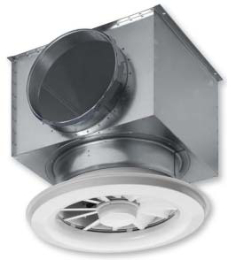
High Exposure Diffusers

Swirl Diffusers
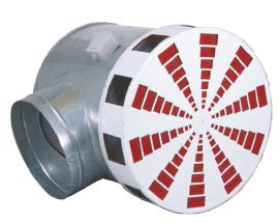
Ideal Comfort Diffuser
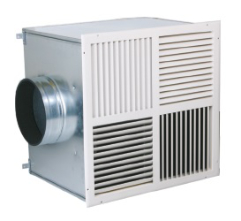
Multi Directional Diffuser
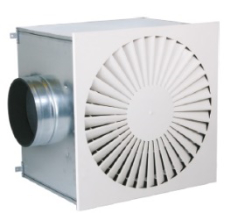
Turbulance Diffusers
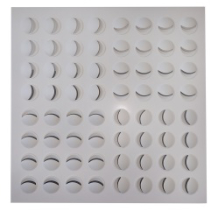
Oyster Shaped Diffusers
The purpose of an industrial ventilation system is to reduce exposure to excess heat and contaminants generated in an industrial environment. The most effective method of removing excess heat and contaminants is at the source with a local exhaust system. Another method is dilution with general ventilation by either a fan system, natural draft or a combination of the two. In some cases cooling is required to maintain acceptable space conditions, either for people or processes. Gmcair manufactures multi-blade industrial grille, registers and diffusers for industrial installations requiring high velocity and static pressure capabilities. Available in square/rectangular options with individually adjustable blades, these units are custom built to meet specific job requirements.
Many industrial applications require a combination of local exhaust, general ventilation supply and general exhaust to handle simultaneous removal of heat and contaminants. Due to the unique and extreme conditions experienced in the industrial environment, specific air outlet models have been developed for this application. Those include
Those include
Note: Supply grilles or nozzles should include a means of adjusting the direction of airflow to facilitate changes to the work area layout or due to seasonal variations.